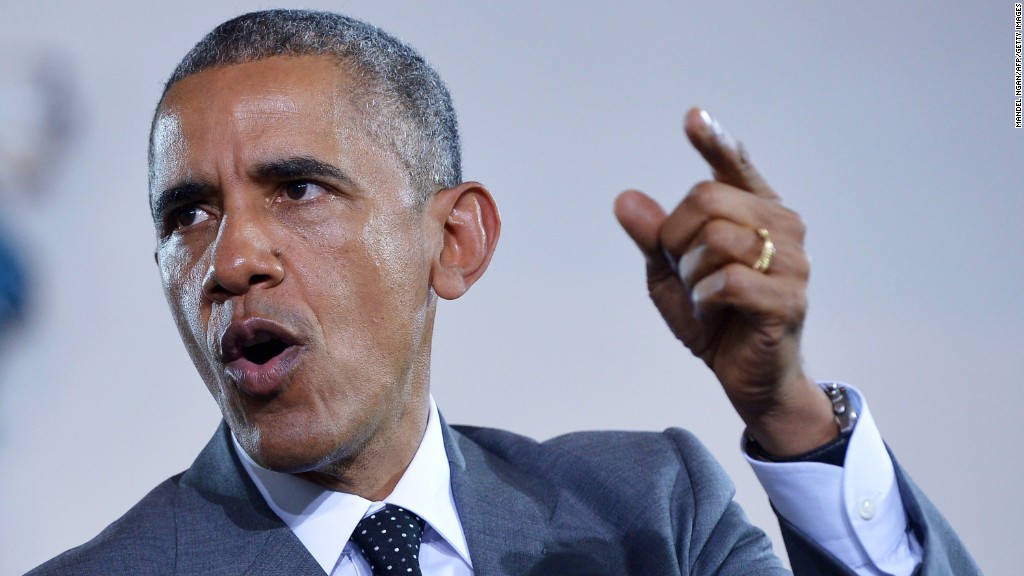President Barack Obama’s approval rating is shifting back toward positive territory, as the public’s take on the economy hits a new high mark for Obama’s tenure, according to a new CNN/ORC poll.
For the first time since May of 2013, more Americans polled say they have a positive impression of how Obama is handling the presidency than a negative one: 48% approve of the way Obama is handling his job, while 47% disapprove.
While the share saying they approve is not significantly larger than the share disapproving, it’s a notable shift in perceptions of Obama’s presidency.
Obama’s numbers are on the rise at the same time the public gives the economy the highest ratings of his presidency.
The poll finds 52% describe the U.S. economy as very or somewhat good, while 48% call it very or somewhat poor. That marks the first time since Obama took office that significantly more people describe the economy as “good” than “poor,” and only the second time since then that a majority has described the nation’s economy as “good.”
The last time significantly more Americans called the economy “good” than “poor” in CNN/ORC polling was September 2007.
Likewise, the public’s outlook for the country’s economic future is remarkably positive. Sixty percent say they expect the economy to be in good shape a year from now, while just 38% say they think it will be in poor shape. That’s the most positive outlook since the height of the 2012 election campaign. Such campaigns typically boost optimism about the economy as people on both sides of the ideological divide believe their candidate will win and ultimately turn things around.
But outside of that campaign, the last time optimism about the economy reached 60% was in April 2009, about three months into Obama’s time in office.
Following Obama’s re-election in November 2012, his approval ratings took a turn for the better, hitting 55% in January of 2013 just before his second inaugural. But they did not hold.
In June 2013, revelations about National Security Agency surveillance of American citizens preceded a sharp drop in Obama’s ratings. The President lost the most ground among young adults then, falling from 65% approval among 18-29 year olds in May to 48% the following month. His support has held around 50% in CNN/ORC polls among that age group since. But in the new poll, approval among 18-29 year olds grew to 57%.
As among young people, other shifts in Obama’s favor have come largely from the President’s base. His approval ratings now tilt positive among women (51% approve to 43% disapprove, compared with 47% approve to 49% disapprove in last month’s CNN/ORC poll), and have also improved among Democrats (88% approve now compared with 82% in March), notably, liberal Democrats (from 90% approve in March to 97% now).
Economic factors can trump other issues and boost a President’s approval rating to stratospheric heights.
At this point in his presidency, Bill Clinton held a 60% approval rating following his impeachment trial over the Monica Lewinsky scandal, largely buoyed by a strong economy. George W. Bush posted a 36% approval rating in April 2007, buffeted by the war in Iraq despite mostly positive reviews of the economy.
And the spring of Ronald Reagan’s seventh year in office saw him earning a 48% approval rating from the public, a rating that was just beginning to recover from the Iran-Contra affair and didn’t get any boost from a tepid economic climate.
Americans current growing optimism may be due to feelings that their own personal financial standing is improving. The poll finds 42% say they are better off financially than they were a year ago, 34% that they are worse off while 23% are in about the same situation.
When the CNN/ORC Poll last asked this question in June 2013, more said they were worse off (44%) than better off (36%).
Still, some see limitations to the nation’s economic growth: About half (48%) of adults say they see America as divided into “haves” and “have-nots;” 50% do not see it that way.
Presidential contenders from both the Democratic and Republican parties have focused on economic inequality as a central issue in their fledgling campaigns, yet views on this question are sharply divided by party. Among Democrats, 61% say the nation is divided into haves and have-nots, while 61% of Republicans say it is not divided. Among independents, 46% say it is split, 52% that it is not.
After three months at the helm of both houses of Congress, the Republican leadership hasn’t won over many outside its own party, and isn’t reaping the benefit of improved economic attitudes.
Overall, 28% approve of what the Republican leaders in the U.S. House and Senate have done so far this year; 67% disapprove. That includes a 63% approval rating among Republicans, but just 21% of independents and 15% of Democrats agree.
More approved of the Democrats in 2007 after they recaptured both the House and the Senate in the 2006 elections, largely on account of higher approval ratings among independents. By March of 2007, 47% of U.S. adults said they approved of the Democratic leadership’s performance, with independents evenly split, 41% approve to 40% disapprove.
The CNN/ORC International poll was conducted by telephone April 16-19 among a random national sample of 1,018 adults. Results from the full poll have a margin of sampling error of plus or minus 3 percentage points.



